The Kids Corner Bookmobile

Pet Sounds (27)
Canine influenza, also called dog flu, is caused by an influenza A virus. In 2004, the first strain, H3N8 was reported in racing greyhounds in Florida. Shortly after the problem arose in Florida, other states, which permit greyhound racing, were faced with respiratory disease outbreaks. Eventually, the virus was reported in at least 40 states and Washington, D.C.
The second identified strain, H3N2, was originally reported in Korea, China and Thailand. It was not detected in the U.S. until the spring of 2015 when an outbreak in the Chicago area affected more than 1,000 dogs. In the past two years, thousands of dogs across the U.S. have been infected.
Dogs that are infected by the canine influenza virus can develop mild or severe disease or become asymptomatic carriers. Dogs with the mild form of the disease present with a cough, sneezing, discharge from the nose and eyes, a decreased appetite and lethargy. Dogs with the severe form of the disease initially develop the aforementioned symptoms, but eventually develop high fever and pneumonia. These dogs usually require hospitalization and supportive care including antibiotics, intravenous fluids and oxygen therapy. Fortunately, the majority (80%) of dogs will develop the mild form and recover within 2-3 weeks. Less than 10% of affected dogs will die from the influenza virus.
Although most dogs infected by the influenza virus will become ill, approximately 20-25% of dogs will show no symptoms of illness. These asymptomatic dogs are dangerous in that they are carriers and can transmit the virus to other dogs. Because of the highly contagious nature of the influenza virus, notify your dog’s veterinarian immediately if you notice coughing, nose or eye discharge, lethargy or a decrease in appetite.
If your dog is showing respiratory symptoms, do not visit dog parks, doggie daycare, groomers or boarding facilities. Be sure to notify the veterinary office of the nature of your dog’s symptoms when you call to schedule an appointment. The office staff will likely instruct you to wait outside until you and your dog are ready to be seen. Expect to be directly ushered into an examination room and avoid approaching or coming into contact with other dogs.
At your dog’s visit, the veterinarian will perform a physical exam, take your dog’s temperature, draw blood and possibly recommend chest x-rays and a nasal swab to test for the influenza virus. Based upon your dog’s symptoms, the veterinarian will discuss treatment options.
A bivalent vaccine is available which offers protection against both the H3N8 and H3N2 strains. The vaccine will reduce the risk of a dog contracting the virus and, although not guaranteed to completely prevent disease, it will minimize the severity and duration of illness.
In order to reduce the risk of your dog becoming infected with the influenza virus, necessary precautions must be taken. If your dog’s lifestyle includes play dates at a park or daycare, if your dog participates in agility or dog show competitions, or boards at a kennel, the bivalent vaccine is recommended. As an added safety measure, before allowing your dog to visit kennels or facilities in which many dogs are in close contact, ask whether the influenza vaccine is required and if screening procedures are in place. Do not wait until the last minute to have your dog vaccinated. The bivalent vaccine requires a series of 2 injections, 2-4 weeks apart. Your dog should receive the final booster at least 2 weeks prior to potential exposure to ensure appropriate immunity.
Noise Phobia
Even once July 4th has passed, fireworks can still be randomly heard throughout the summer months and they are guaranteed New Year’s Eve. In addition to fireworks, pets with noise phobias can also be scared by thunderstorms, gun shots, backfires, construction, and motorcycles. While cats can also be fearful of loud noises, dogs are more commonly affected. A survey conducted last year indicated that 44% of dogs have noise aversion.
A phobia is “an extremely strong dislike or fear of something.” Examples of common phobias that affect people include heights, snakes, rollercoasters. Once fearful of an experience, it is difficult to overcome that fear in the future.
Thunderstorms are different than other events merely associated with noise. Dogs often become fearful before the storm arrives. Dogs begin to react when they sense a change in the barometric pressure or when they hear and see rain and wind. Both thunder and lightening associated with storms can dramatically affect dogs. Surprisingly, not all dogs with storm phobias are affected by loud noises and not all dogs afraid of loud noises are sensitive to storms.
Noise phobias are not only stressful for the afflicted dog or cat, they can be very unsettling for the pet parent. Watching your pet in emotional distress is heart breaking. Pet owners often feel helpless when it comes to comforting an upset dog or cat. Common symptoms of noise phobia include:
• Pacing
• Panting
• Whining/barking/meowing
• Drooling
• Hiding
• Destructive behavior
Some dogs will show subtler signs such as lip licking, yawning, or just remaining stationary out of fear.
If your dog or cat is very fearful of loud noises or storms, consult your pet’s veterinarian. Suggestions can be offered to help minimize your pet’s anxiety. One strategy is avoidance. By avoiding the offensive stimulus, your pet will have nothing to fear. However, since we cannot control the weather, avoid neighbors who light fireworks, or prevent local construction, this is easier said than done.
As pet owners, we can take measures to minimize our pet’s fear. For example, when fireworks or storms are expected, keep your pets inside and play the television or radio at a loud volume to drown out the offending noise. Some dogs can be distracted by providing a Kong toy stuffed with peanut butter. Allow your pet to hide wherever it feels comfortable. Never scold a pet or try to make it leave a secure hiding location! Many dogs seek shelter in bathrooms and specifically bathtubs.
During storms or fireworks, try to engage your dog in a playful game or obedience skill to redirect its focus. Nonprescription medications can be tried. There are pheromone products such as Adaptil for dogs and Feliway for cats that can be helpful. These products mimic the natural chemicals released by a nursing mother dog or cat and provide a sense of calm for pets. “Rescue Remedy” is a natural product that can also create a calming effect for stressed pets. A “Thunder Shirt” is a snuggly fitting coat that “hugs” the pet and gives a sense of security.
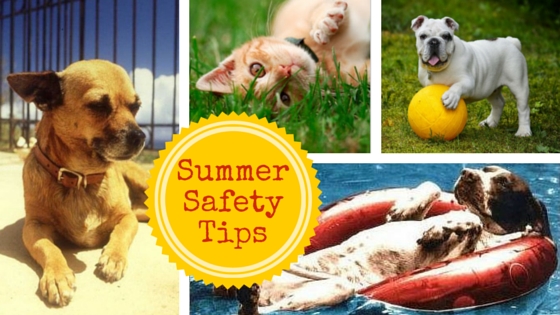 If non-medication products do not provide enough stress relief, a veterinarian should be consulted to discuss medications for your anxious pet. There are many different medications that can be tried, but not all can resolve noise phobias. Some pets benefit from a multimodal approach. Finding the solution to a pet’s anxiety requires time and patience and often the best plan is discovered by trial and error.
If non-medication products do not provide enough stress relief, a veterinarian should be consulted to discuss medications for your anxious pet. There are many different medications that can be tried, but not all can resolve noise phobias. Some pets benefit from a multimodal approach. Finding the solution to a pet’s anxiety requires time and patience and often the best plan is discovered by trial and error.
Heat Related Illness
The Philadelphia area has already experienced several heat waves this summer. Heat and high humidity pose dangerous risks to both people and pets. Dogs are susceptible to heat stroke when allowed to exercise on hot and humid days or when accidentally placed in a confined space such as an automobile. A study found that the temperature within a vehicle may increase by an average of 40 degrees Fahrenheit within one hour, even on a relatively cool (70 degree) day.
While all dogs can develop heat related problems when exposed to adverse conditions, some dogs are particularly susceptible. Unlike people, dogs do not sweat to cool their bodies. Dogs rely on evaporative cooling from the tongue, by means of panting. Dogs with flat faces such as Bulldogs, Pekingese, Pugs, Boxers and Boston Terriers are at a disadvantage when it comes to regulating normal heat balance. Dogs that are elderly, overweight, have heart disease, or have laryngeal paralysis are also more prone to becoming overheated.
Animals with heat-induced illness can develop the following signs:
• excessive panting and drooling
• red or pale gums
• vomiting
• diarrhea
• weakness and collapse
More severe signs include vomiting blood and difficulty breathing. All body systems (kidneys, liver, gastrointestinal tract, coagulation factors) can be affected by heat-induced illness. If not caught and treated immediately, the patient can develop life threatening multisystem failure, sepsis, and deregulation of the blood clotting system. Seizures and coma may develop if heatstroke progresses resulting in cardiac arrest and death.
If you suspect your pet is suffering from heatstroke, spray the pet with cool water or immerse in a cool water bath. Do not immerse pet in ice bath! Direct fans towards dog to further help with body cooling. Transport your pet to the nearest veterinary hospital.
To prevent heatstroke:
• Never leave pets in a hot parked car.
• Provide access to water and shade on warm days.
• Do not allow dogs to heavily exercise on hot and humid days.
• Walk pets early in the morning of after sunset during the summer.
• Never muzzle dogs in hot environments, take caution with dryers used at grooming facilities
It is much better to prevent heatstroke than to treat it!
Out and About with Dogs
Dining Out
One of the best things about the warm weather is the ability to dine out with your dog. Pet friendly restaurants are becoming more common. Be sure your dog is well behaved and will be welcome at a restaurant before making a reservation. Since most restaurants are only permitted to allow dogs in certain areas, call ahead to reserve a table at which you and your dog will be able to dine. If rain is forecasted, be sure that a covered area is available for shelter. If you plan on dining mid day, be sure shade is available to prevent your dog from experiencing heat related problems. While most restaurants which welcome dogs provide water bowls, always bring your own water supply as well as treats to keep your dog happy and hydrated.
Beach Visits
Before heading to a beach with your pup, investigate whether dogs are allowed. Even if dogs are permitted to run freely, always bring a leash. This will ensure that you can control your dog around small children and ensure safely when close to roads. If your dog will be swimming, a life vest is always a good safety precaution. If the weather is extremely hot, be sure to pack an umbrella or tent to provide shade for your dog. Also bring cool water and a blanket. Be careful that your dog does not burn its pads on hot sand. For the health and well being of other beachgoers and their canine companions, always pack enough poop bags. No one wants to step in dog poop with bare feet!
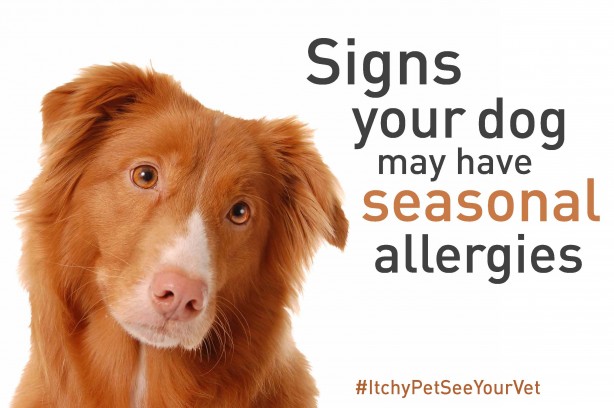 Although a meteorology report makes it official, you only need to look at an outdoor object such as a car to know that the pollen count is high. It is during this time of the year that you should not only be washing your car with greater frequency, but also your dog. Spring allergies often seem worse than those during the summer and fall. People and pets’ heightened symptoms of springtime allergies are possibly due to a greater number of airborne inciting agents or the fact that humans, dogs and cats receive an allergy reprieve during the winter months. While there is no cure for the annoying problems associated with allergies, people and pets can receive relief with various treatments.
Although a meteorology report makes it official, you only need to look at an outdoor object such as a car to know that the pollen count is high. It is during this time of the year that you should not only be washing your car with greater frequency, but also your dog. Spring allergies often seem worse than those during the summer and fall. People and pets’ heightened symptoms of springtime allergies are possibly due to a greater number of airborne inciting agents or the fact that humans, dogs and cats receive an allergy reprieve during the winter months. While there is no cure for the annoying problems associated with allergies, people and pets can receive relief with various treatments.
Sneezing and a runny nose and eyes are the most common allergy symptoms in people. Pets with air borne allergies to substances such as molds, pollens and grasses tend to become itchy. If you notice your dog or cat excessively biting or licking its legs and paws, or scratching its head, face or armpits, schedule an appointment with your pet’s veterinarian. If untreated, pets with allergies can bite or scratch their skin to the point of causing significant injury and infection.
Ear infections and hot spots are two common manifestations of allergies. Since the ears are an extension of a pet’s skin, ears often become inflamed and infected secondary to allergies. When a dog or cat scratches or shakes its head vigorously, the small blood vessels in the ear can break. The blood from damaged vessels accumulates between the two folds of ear cartilage resulting in a swollen ear known as an ear hematoma. This is a very uncomfortable condition for pets and often requires surgery.
Hot spots are a painful area of skin that results from excessive scratching, rubbing or biting. The name implies the severe inflammation at the site. Hot spots are often moist and pet families will notice damp skin or sometimes a bad odor coming from the site. Hot spots and ear infections are very painful and need immediate veterinary attention and care.
In addition to air borne allergies, dogs and cats can also develop itchy skin from food allergens and external parasites. Through diagnostic testing and and the acquisition of a thorough history, your veterinarian can narrow down the list of possible allergens. In order to determine whether certain foods are responsible for a pet’s itchiness, an “elimination” diet may be necessary. This food trial usually involves feeding a new protein and carbohydrate source or a prescription veterinary diet. An examination of your dog’s or cat’s skin and fur is needed to diagnose a mite or flea infection. Determining the source of your pet’s allergies is critical in order to develop the best treatment plan.
Allergies are very frustrating as there is no permanent cure, and once diagnosed, allergies typically require life long treatment. Fortunately, recent scientific advances have created numerous options for managing dog and cat allergies. There are several oral medications available from your pet’s veterinarian. For dogs and cats for which it is difficult to administer a daily pill or liquid, injectable medications can be used. Pets that undergo tests to identify specific allergens are candidates for either injectable (allergy shots) or oral desensitization medication.
In addition to prescription medications, pet parents can administer over the counter allergy medicines such as antihistamines. Always be sure to consult a veterinarian before giving any medication to your pet! The benefits of allergy medications are often strengthened by bathing.
While bathing may not be necessary for, or appreciated by indoor cats, shampooing can significantly help allergic dogs that spend a lot of time outdoors. Medicated shampoos not only remove allergen particles from a dog’s skin, they also provide immediate itch relief. Since bathing is time consuming, in between weekly baths, families can wipe their dog’s fur and paws with a damp cloth each time it returns from being outdoors.
Pet allergies can be frustrating, time consuming and expensive to treat. Dogs and cats that do not receive therapy can be miserable and suffer from unrelenting itchiness and significant medical issues. Pet families need to pay close attention to their dog or cat for signs of itchiness or skin problems. If treated early, and managed with close veterinary supervision, allergic dogs and cats can lead normal and happy and healthy lives.
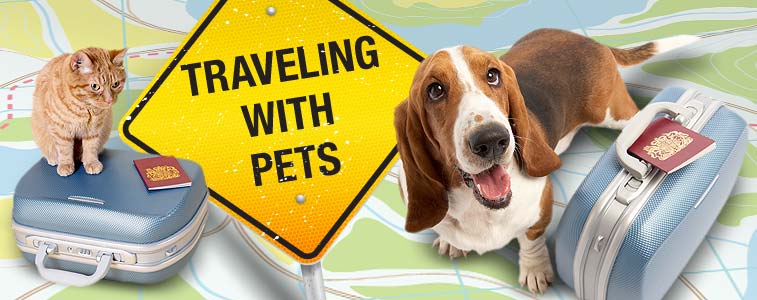
TRAVELING WITH PETS
Now that many hotels and privately owned accommodations are opening their doors to pets, traveling with furry companions has become an option for many families. Planning ahead is important whether you are traveling with or without pets. Call ahead to find out any restrictions (size of dog, leaving pet alone in room)
If traveling by car:
- Be sure your pet is comfortable in car (not anxious, not prone to car sickness).
- Seat covers protect car fabric and prevent dog from slipping.
- Safety harness or travel carriers help to secure dog in case of sudden stops or accidents.
- Keep cats in carrier for their safety as well as preventing driver from being distracted.
- If feeding ahead of time, provide a very small meal.
- Do not allow dog to stick head out of window - particles can get into eyes, other flying objects could be dangerous
If flying:
DO NOT FLY WITH SICK OR DEBILITATED PETS, THEY WILL NOT BE ABLE TO HANDLE THE STRESS!
- Call airline ahead of time to learn specifications for travel with pet (health certificate, vaccinations, size restrictions)
- Book a direct flight and book early as the number of pets is limited per flight.
- Health certificates signed by a veterinarian are usually needed within 10 days of travel.
- Investigate carrier specifications well ahead of time.
- Cats and small dogs traveling in the plane’s cabin need to be in small, soft sided carriers.
- Dogs traveling in cargo section should be in sturdy carriers labeled “live animal” with arrows showing upright position.
- Be sure carriers are well labeled with your contact information, pet’s name and destination.
- Request an aisle seat. Avoid sitting behind the bulk head as there will be no seat under which you can place a carrier.
- Allow pets to spend time in carriers before travel so they will be acclimated
NEVER SEDATE PET FOR FIRST TIME ON DAY OF TRAVEL
- Tranquilizers can be very unpredictable.
- Always do a trial with medication before you travel to see how pet will react.
- Line carrier with paper towels or pee pee pads in case of accident.
IF FLYING OVERSEAS, AN INTERNATIONAL HEALTH CERTIFICATE IS NEEDED. THIS MUST BE OBTAINED BY AN ACCREDITED VETERINARIAN.
Other tips:
Items to pack
- regular food, treats, dishes, bed, toys, fresh water
- leash or harness
- medications (heartworm preventative, flea/tick medications, seizure medication, other important daily medicine)
- bland food and medications in case pet has a sensitive stomach (consult your dog’s veterinarian)
- research phone numbers of local vets, emergency clinics in case needed
- Bring number for ASPCA Poison Control 1-888-426-4435
- be sure pet has ID tag with cell phone number, temporary ID tags can be made with address of where you are vacationing
- pooper scooper/bags and litter box + litter
- recent photo of pet (in case it gets lost)
- proof of vaccines and medical records
- grooming supplies (shampoo, brush)
- carpet cleaning product in case of accidents
First Aid Kits are recommended
- bandages, Telfa pads, gauze
- triple antibiotic ointment
- styptic powder for broken nails
- digital thermometer and lubricating jelly
- hydrogen peroxide /saline solution for cleaning wounds
TRAVEL WITHOUT PETS
Travel plans can be very exciting and it may be easy to become distracted from making the necessary arrangements for pets prior to your vacation. Be sure to make arrangements for pets to be taken care of in your home, to stay with a friend, or to stay at a boarding facility.
DO NOT WAIT UNTIL THE LAST MINUTE! BOARDING KENNELS BOOK UP QUICKLY AT HOLIDAY TIMES AND IN THE SUMMER MONTHS. MAKE SURE YOUR PET SITTER WILL BE AVAILABLE WHILE YOU PLAN TO BE ON VACATION.
If leaving a pet at home, be sure to choose a reliable pet sitter. Make sure he/she is well acquainted with your pets - the last thing you want is for your dog to not allow the sitter into your home!
Leave a written list of instructions for sitter.
- note amount of food to be fed, normal feeding times, number of treats/snacks
- note how often and at what times dog goes out to go to the bathroom
- note any common problems to monitor (cat with urinary problems, pets with seizures, arthritis, diarrhea, etc)
If leaving pets in kennel:
- Get referrals to make sure facility is reputable.
- Make sure that if kennel is not affiliated with vet hospital, they will be able to provide medical care in case of emergency.
- Make a scheduled and surprise visit to kennel to evaluate
- Bring pet’s favorite toys, blankets, and regular food to avoid likelihood of vomiting or diarrhea
Whether leaving pet with sitter or in kennel, ALWAYS LEAVE EMERGENCY CONTACT NUMBERS
GIVE PET SITTER CONSENT TO APPROVE MEDICAL TREATMENT IN CASE OF EMERGENCY. You can call vet office to let them know pet sitter has authority to okay any treatment needed. You can even leave credit card number on file.
Some helpful websites:
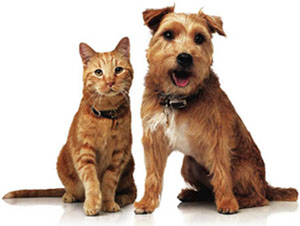 Basic guidelines for feeding dogs and cats
Basic guidelines for feeding dogs and cats
Choose a food with packaging containing a statement from the Association of American Feed Control Officials (AAFCO). The inclusion of this statement indicates that the diet has either been tested via food trials or has been analyzed to meet nutritional guidelines.
For puppies and kittens, choose food designated for “growth” or “all life stages.” Puppies and kittens have different nutritional needs than adult dogs and cats. It is important to feed an appropriate life stage diet until your pet reaches skeletal maturity (small and medium dogs and cats = 1 year, large breed dogs = 18 months).
Large and giant breed dogs require an even more specific diet. These dogs, such as Labrador Retrievers, Golden Retrievers and Great Danes, have a very rapid growth rate. It is therefore necessary to feed a diet formulated to help prevent developmental disorders related to their quick growth. Look for labeling with statements such as “large breed puppy formula.”
There are a multitude of food choices for adult dogs and cats. In fact, many pet parents are overwhelmed by the the number of options presented in pet stores. When it comes to choosing a food for your adult dog or cat, there are several important factors to consider such as weight and health. Obesity affects more than half of the dogs and cats in the U.S. If you are unsure whether your pet is at a healthy weight, consult a veterinarian. Your pet’s doctor can make suggestions for safe ways to promote weight loss. There are many health conditions for which prescription or specialized diets exist. Health issues that can be managed with specific diets include allergies, urinary problems, liver and kidney disease, diabetes and arthritis. There is now a special diet for pets that suffer from seizures.
While pet food manufacturers produce diets labeled for “senior” dogs and cats, there has yet to be a standardization for such a designation. As pets enter their mature years, each one has individual needs. It is therefore best to consult your pet’s veterinarian for recommendations specific to your pet.
Raw diets have become equally popular and controversial. These diets pose a risk to both pets and their families for bacteria such as E. coli and Salmonella as well as parasites. Bone fragments in raw diets can result in broken teeth and can also cause severe damage to the gastrointestinal tract of dogs and cats. Raw diets are often not nutritionally balanced and pose a risk of vitamin A toxicity due to the high liver content.
For more information, visit
www.Wsava.org/nutrition-toolkit
The responsibilities of pet care
- Provide clean bowls with fresh food and water daily
- Basic veterinary care
- Examinations
- Vaccines
- Spay and neuter: prevents medical problems and unwanted puppies and kittens
- Fecal and blood tests
- Heart worm, flea and tick prevention
- Dental care (home care and professional cleanings)
Become familiar with what is normal for your pet (poop appearance/frequency, appetite, water consumption) and what situations warrant a call to a veterinarian such as:
- Vomiting
- Diarrhea
- Coughing/Sneezing
- Decreased Energy
- Limping
- Ingestion of toxic food (grapes, raisins, chocolate)
- Ingestion of objects such as toys, articles of clothing
- Seizures
- Difficulty breathing
Provide regular exercise for physical and mental health
Having a pet requires taking the financial responsibility for its well being. Owning a pet can be very expensive when you consider the cost of basic care (food, toys, bedding), boarding/pet sitter/doggie daycare/dog walker, medical care (surgery, prescription food, medicine, blood tests, veterinary visits).
6. You must make a time commitment for walking the dog before school and bedtime, training and spending quality time together.
7. It is also important to choose a pet appropriate for your lifestyle, taking into account your free time and available living space. For example, getting a Great Dane when you live in a small apartment might not be the best idea.
Listen as Dr. Mindy Cohan talks with Kathy about keeping your pet happy - and also tips on dealing with the death of a pet
 February is Valentine's Day - when people decorate with hearts - so Dr. Mindy Cohan joined us to talk about both Happy Hearts and Broken Hearts: things you can do to pamper your pet ... and ways to process the sadness when dealing with the death of a pet.
February is Valentine's Day - when people decorate with hearts - so Dr. Mindy Cohan joined us to talk about both Happy Hearts and Broken Hearts: things you can do to pamper your pet ... and ways to process the sadness when dealing with the death of a pet.
Showing that doggie love:
* Make homemade treats
* Visit a dog bakery
* Take a walk, run or hike (great exercise and mental stimulation)
* Go to a pet store and let your dog choose a new toy
* Buy a treat/food dispensing ball
* Take your dog on a trip to a pet friendly bed and breakfast or hotel (www.bringfido.com and www.petfriendlytravel.com)
* Buy a safety harness for car travel
* Purchase a new leash and matching collar
* Snuggle on a sofa while reading or watching television
* Enroll your dog in doggie day care or arrange for a dog walker if you will be away from home during daytime hours
* Go for a ride in the car (assuming your pup does not get car sick)
* Spend one on one time teaching a new trick or attend agility class together
* Play time (toss a ball or toy)
* Take your dog for a swim (Labs, Golden Retrievers, Portuguese Water Dogs, Standard Poodles)
* Give belly rubs, back scratches
* Talk to your dog
* Morning cuddles in bed
* Special treats (Frosty Paws)
* Bathe and brush your dog
* Buy a new plush bed
Tips for coddling your cat:
* Buy new toys (laser pointer, feather wand, motorized mouse)
* Combing helps to prevent mats and hairballs and many cats enjoy being brushed
* Buy a cat tree or climbing furniture which provide a great look out spot, sense of security from house guests or other resident pets
* Place a soft bed in the sunshine or by a window
* Set up a window sill perch which allows for all day entertainment of watching birds, squirrels
* Provide multiple scratching posts with various textures
* Purchase a harness for walks outside
* Set aside time to snuggle on a sofa
* Leave a video on while out of the house featuring birds or fish
* Growth fresh catnip
* Provide plenty of litter boxes, cleaning them multiple times daily
* Give a gentle massage
Dealing With Broken Hearts
As a veterinarian and pet parent, I understand the devastation that follows the loss of a pet. For many children, the loss of a pet is their first experience with death. Children mourn differently than adults and expressions of grief can vary depending on the child’s age. It is very important for parents to allow children to grieve in their own personal fashion.
The bond between children and their pets is extremely strong. A recent study found that children can prefer their pets to siblings. Pets provide unconditional love, they serve as loyal confidants, pets are always available as playmates and they provide children with a sense of security during scary or sad situations. The loss of a companion which served so many important roles in a child’s life can result in tremendous grief.
Grief is a perfectly natural reaction to the death of a loved one. Grieving for a pet is a tribute to the special relationship that was shared. Shock and disbelief are very common initial reactions to the loss of a beloved pet. Shock is particularly common when the death occurred suddenly and unexpectedly. Guilt is another common emotion, especially if the pet died as a result of an accident. Sadness is a normal emotion following a death, yet many people who are not animal lovers may say insensitive things such as, “It was only a pet” or “You should be over it by now.”
Symptoms of grief are shared by adults, children and even the surviving pet family members. Common physical and emotional manifestations of grief include:
Crying
Decreased appetite
Sleeping more or less
Lack of concentration
Lack of energy/motivation
Anxiety
Irritability
Sadness/depression
Feeling overwhelmed
Suggestions for helping children before or after the loss of a pet include:
Allow the child to see you cry and be sad.
Always be straightforward and honest when answering a child’s questions.
Do not force a child to discuss his/her feelings, give them time and space.
Offer to help a child memorialize a pet. Set up a tribute table to include photos, a collar or leash, toys, bowls, a lock of fur. Help a child to write a poem or letter to the deceased pet. Plant a flower or tree in the pet’s memory. Allow the child to participate in a memorial service.
Avoid using terms such as “put to sleep” or inaccurate stories such as “Fluffy went to a farm.”
Reassure a child that they were not at fault for the pet’s death.
Do not replace the pet before the child has a chance to mourn.
· Resources for grieving pet families
Books for children
Dog Heaven – Cynthia Rylant
Cat Heaven – Cynthia Rylant
The 10th Best Thing about Barney – Judith Viorst
Books for Adults
When a Pet Dies – Fred Rogers
Children and Pet Loss: A Guide for Helping – Marty Tousley
When Your Pet Dies: A Guide to Mourning, Remembering, and Healing – Alan Wolfelt
Listen as Dr. Mindy Cohan talks with Kathy about adopting a pet and holiday safety tips!
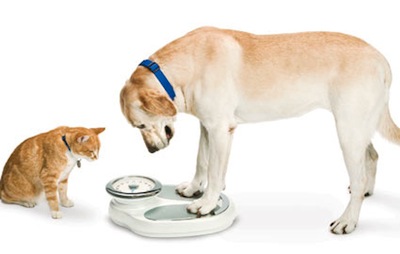 People and pets have a lot in common. Unfortunately, both are suffering from an obesity epidemic. In recent years, obesity has been recognized as a human disease. Now, there is discussion in the veterinary community as to whether to classify pet obesity as a disease. If the obesity problem in pets is recognized as a disease, it will help to bring greater awareness to this common problem that affects over 50% of dogs and cats in the U.S.
People and pets have a lot in common. Unfortunately, both are suffering from an obesity epidemic. In recent years, obesity has been recognized as a human disease. Now, there is discussion in the veterinary community as to whether to classify pet obesity as a disease. If the obesity problem in pets is recognized as a disease, it will help to bring greater awareness to this common problem that affects over 50% of dogs and cats in the U.S.
Many people set new year’s resolutions to make healthier food choices and to exercise more. In order to get the new year off to a good start for your pet, consult your pet’s veterinarian to see if a weight loss plan is needed. Our pet’s need our help in order to succeed in reaching a healthy weight. A veterinarian can make recommendations to help you know what type of food and what amount is best for your pet. Your veterinarian will also decide how much exercise is safe for your pet. Remember, you would not start off running 10 miles daily. Pets that have not had regular exercise need to be slowly introduced to becoming more active.
Taking simple steps such as regular walks and playtime with your dog can make a big difference. Since most cats can’t rely on walks outside to burn more calories, pet parents must think of creative ways to get their feline friends moving. Laser pointers and feather wands are very appealing to cats and a great way to encourage indoor activity. A food dispensing ball is a great way to make your cat’s food last longer while also providing exercise as your cat chases it around the house. The new NoBowl feeding system for cats was designed by a veterinarian and offers many benefits such as weight management, preventing rapid eating followed by vomiting, exercise, and positive mental stimulation for the cat’s overall well being.
Harnesses and Walking Cats
Some cats enjoy being walked on a harness outside. This is a safe way for them to explore the outdoors and get exercise. Make sure your cat tolerates the harness, put it on at home before feeding. This will help the cat to have a positive association with the harness.
- lay harness on floor near food dish
- lay harness over cat without buckling it and feed treats
- attach leash to harness and let the cat roam in the house with leash attached, give treats
- lead the cat around the house with leash attached to harness. Once the cat is used to the harness, venture outside.
Benefits of a Harness
- Exercise
- Mental stimulation, less behavioral problems
- Better sleep at night for cat and owner
- Bonding time
Excessive treats and table food are often the biggest culprits of weight gain in pets. Decreasing the frequency of treats as well as the quantity is critical for a successful weight loss program. Instead of feeding your dog an entire biscuit, feed just a small piece. Cat treats are fine as a reward, but do not feed them indiscriminately. Avoid feeding your dog from the table. Human table food adds many unaccounted calories to a dog’s daily intake.
Studies have shown that an overweight pet has a significantly shorter life span than a pet at a healthy weight. In addition to not being able to enjoy as many years with your pet, overfeeding is putting your pet at risk for many medical problems such as:
- Arthritis
- Heart and respiratory issues
- Cancer
- Injury to ligaments
- Intervertebral disc disease (especially breeds including the Beagle, Dachshund, Corgi)
- Diabetes
- High blood pressure
February is National Pet Dental Health Month
Many dog and cat owners wait until their pet’s breath is offensive before seeking dental care. Veterinary exams on a biannual or at least yearly basis are very important and should include a thorough oral evaluation. Pet owners should not be surprised or alarmed if their veterinarian recommends a professional teeth cleaning. A teeth cleaning by a veterinarian will be performed under general anesthesia since we cannot rely on dogs and cats to remain still for the procedure.
Studies show that at least 85% of pets have periodontal disease by three years of age. The progression of dental disease begins with plaque formation. Plaque is comprised of saliva and bacteria. Plaque hardens and becomes tartar, a mineralized, dense material that is beige and visible on the tooth surface. The bacteria within tartar are harmful and cause damage to the tooth ligament and surrounding bone. Eventually the tooth will become loose and the bacteria can enter the blood stream, affecting the heart, liver, kidneys and brain.
Signs of dental disease include:
- bad breath
- tartar
- red or swollen gums
- pain or bleeding when the pet eats or when the mouth is touched
- decreased appetite or difficulty chewing
- loose or missing teeth
- swelling underneath an eye (can indicate a tooth abscess)
While gingivitis, an inflammation of the gums is reversible, periodontal disease is not. To prevent the progression of dental disease, regular home care and periodic professional cleanings are recommended. Brushing a pet’s teeth on a daily basis is the most effective means of preventing dental disease. Veterinary brushes and finger brushes are available. It is very important to use only veterinary toothpaste. Human toothpaste is not meant to be swallowed and can be harmful to dogs and cats.
For a video demonstration on brushing your pet’s teeth, please visit
https://www.youtube.com/watch?v=PsNlLLSBWLU
To see which dental products the Veterinary Oral Health Council (VOHC) approves, please visit
www.vohc.org/accepted_products
If your pet shows signs of a dental problem, or you have questions regarding your dog or cat’s oral hygiene, please consult your veterinarian.
Listen as Dr. Mindy Cohan talks with Kathy about things to keep out of your pet's reach!
Hazardous Substances for Pets
 While people may try to resist the temptation of chocolate, dogs never have the willpower to say, “No.” This accounts for the reason animal poison control hotlines receive more calls about chocolate than any other ingested substance. Although cats can also be affected by chocolate, they rarely give in to their sweet tooth like dogs. Chocolate and coffee contain xanthine alkaloids, the substance which is responsible for the side effects animals experience if they ingest either product. The xanthine alkaloid in coffee is caffeine and chocolate contains theobromine. Dogs can ingest many types of chocolate including candy bars, cookies, brownies, cocoa mulch and holiday treats such as chocolate hearts and bunnies. The amount of theobromine ingested is dependent upon the type of chocolate and the amount consumed. Baking chocolate poses the greatest risk, while white chocolate is the most benign type of chocolate in terms of theobromine content. Symptoms of chocolate or coffee ingestion include vomiting, diarrhea, hyperactivity, abnormal heart rhythm, tremors, seizures and death. If your dog consumes either chocolate or coffee, it is critical to call your veterinarian or poison control immediately. You will need to report the size of your dog, the suspected quantity consumed, and most importantly, the type of chocolate the dog devoured. Fortunately, if you witness your dog’s consumption of chocolate or coffee, or discover the ingestion soon afterwards, vomiting can be induced to help prevent further absorption and toxicity.
While people may try to resist the temptation of chocolate, dogs never have the willpower to say, “No.” This accounts for the reason animal poison control hotlines receive more calls about chocolate than any other ingested substance. Although cats can also be affected by chocolate, they rarely give in to their sweet tooth like dogs. Chocolate and coffee contain xanthine alkaloids, the substance which is responsible for the side effects animals experience if they ingest either product. The xanthine alkaloid in coffee is caffeine and chocolate contains theobromine. Dogs can ingest many types of chocolate including candy bars, cookies, brownies, cocoa mulch and holiday treats such as chocolate hearts and bunnies. The amount of theobromine ingested is dependent upon the type of chocolate and the amount consumed. Baking chocolate poses the greatest risk, while white chocolate is the most benign type of chocolate in terms of theobromine content. Symptoms of chocolate or coffee ingestion include vomiting, diarrhea, hyperactivity, abnormal heart rhythm, tremors, seizures and death. If your dog consumes either chocolate or coffee, it is critical to call your veterinarian or poison control immediately. You will need to report the size of your dog, the suspected quantity consumed, and most importantly, the type of chocolate the dog devoured. Fortunately, if you witness your dog’s consumption of chocolate or coffee, or discover the ingestion soon afterwards, vomiting can be induced to help prevent further absorption and toxicity.
While xanthine alkaloids have been identified as the problematic substance in chocolate and coffee, the toxic substance in grapes, raisins and currants is unknown. The danger of kidney failure posed by these foods has only come to light in recent years. Not every dog will experience kidney failure after ingesting these foods. Cats and ferrets can also be affected, but the likelihood of these pets consuming grapes and raisins is far less than it is for dogs. Since we don’t know how to identify which dogs will be affected, it is necessary to treat all dogs as if their life is at risk. The quantity that must be consumed in order to cause a problem is also unknown. Therefore, precautions should be taken even if a small amount is consumed. Raisins are found in many common household food products such as cookies, bagels, trail mix and granola bars. The symptoms related to kidney failure secondary to ingestion of grapes, raisins and currants include vomiting, increased thirst and urination, poor appetite, and lethargy. If you witness or discover that your dog has consumed any of these foods, call your veterinarian or poison control immediately.
Nuts pose a serious threat to people with severe allergies. For dogs, macadamia nuts do not cause an allergic reaction, but result in alarming symptoms including vomiting, elevated body temperature, tremors and weakness in the hindquarters. A small amount of nuts can cause these problems. Fortunately, dogs will usually recover from macadamia nut ingestion within 24-48 hours. If you discover that your dog has consumed macadamia nuts, contact your veterinarian immediately.
While raw garlic, onions, chives and leeks may not be as tempting as chocolate, these ingredients found in pizza, onion rings, meat based recipes, and onion dip become a tasty treat for dogs and cats. Onions and garlic contain thiosulfate which creates two types of problems for dogs and cats. Consumption leads to stomach and intestinal upset manifesting in vomiting, diarrhea, drooling and decreased appetite. The other issue is the rupture and loss of red blood cells which results in anemia. Signs of anemia include pale gums, lethargy, increased heart and respiratory rates, weakness, and collapse. Pet owners should avoid sharing any foods containing onions, garlic, chives and leeks with their dogs and cats. If your pet accidentally ingests these foods, contact your veterinarian or poison control immediately.
Another item that is safe for people, but toxic to dogs is xylitol. Xylitol, a sugar alcohol, is an artificial sweetener that is commonly used in many food and non-food products. It can be found in sugar-free chewing gums, breath mints, baked goods, toothpaste, cough syrup, and vitamins. The most dangerous product containing xylitol is peanut butter as this is a food often deliberately given to dogs as a treat. There are two main problems that dogs develop after ingesting xylitol. First, xylitol causes a significant release of insulin from the pancreas. This leads to a dramatic decrease in the dog’s blood sugar level which poses a threat of seizures and coma. Secondly, xylitol causes liver failure. Check all peanut butter labels before giving it to a dog and be sure to keep chewing gum and any baked goods containing xylitol away from dogs. Call your veterinarian or poison control if you discover your dog has ingested anything containing xylitol.
In addition to various foods, there are many medications, plants and household items which pose a threat to pets. It is important to avoid pet exposure to the following:
Medicines:
· Pain relievers such as aspirin, Advil, Tylenol – very toxic to cats
Antidepressants
Stimulants used for the treatment of ADHD
Pain patches (Fentynyl, Lidocaine)
Household products
· Laundry pods
Toilet bowl cleaner
Any product containing bleach
Antifreeze
Drain openers
Fertilizers
Pennies minted after 1983 (zinc toxicity)
Plants
· Sago palm – liver failure, severe GI problems
Lilies (Easter, tiger, Japanese, day lilies) – highly dangerous for causing kidney failure in cats, even a nibble of leaf, pollen can be deadly
Bulb plants (tulip, daffodils, narcissus, amaryllis, hyacinth) – all parts are toxic, but bulb can cause severe gastrointestinal and neurologic signs
Yew – all parts except fleshy berry around seed are toxic, cause fatal cardiac arrhythmia
Philodendron
Dieffenbachia
Peace Lily
Foxglove
Lilly of the valley
Azalaeas
Rhododendron
If your pet has ingested something you believe to be harmful, contact a veterinarian or one of the following organizations for medical advice:
ASPCA poison control hotline: (888) 426-4435, $65 consultation fee
Pet Poison Hotline 855-764-7661, $49 consultation fee
The Pet Poison Hotline app is great for researching the toxicity of foods, plants and medications.
http://www.fda.gov/ForConsumers/ConsumerUpdates/ucm499988.htm
Listen as Dr. Mindy Cohan talks with Kathy about traveling with your dog or cat.
Traveling with Dogs and Cats
Some of my best vacations included traveling with my dog. Having my dog with me alleviated the typical worries of leaving them with a sitter and I didn’t have to suffer from my own form of separation anxiety. While taking your dog on vacation can be a wonderful experience, there are many problems that can arise if you do not plan ahead.
The first consideration is whether your dog will enjoy the travel experience. If you dog is anxious or prone to car sickness, it is best to leave your dog at home. If you are traveling to a destination where other dogs will be present, be sure your dog gets along well with others.
Dogs prone to motion sickness will not enjoy a family road trip. Signs of motion sickness include drooling, vomiting, lip licking, panting, pacing, restlessness, trembling, and yawning. Fortunately, many young dogs often outgrow motion sickness. The symptoms of motion sickness can be worsened by underlying anxiety. To help minimize a dog’s stress levels, make the car an enjoyable place by providing a favorite blanket or toy. Allow your dog to acclimate by allowing it to spend time in a parked car while eating treats. As your dog develops positive associations with the car, begin to take very short drives, gradually increasing the duration. Consult your dog’s veterinarian regarding medications that can help prevent motion sickness and minimize stress and anxiety.
While most cats are not travel enthusiasts, some cats don’t mind car rides and others may need to travel out of necessity (i.e. owner moving to new home). If you are planning a trip with your feline friend, buy a comfortable and safe pet carrier. A carrier is required for airline travel and it will keep your pet safe in an automobile in case of an accident. Cats that are not accustomed to carriers can become very fearful when confined. Leaving a carrier on the floor with the door open and treats inside can help a cat acclimate before it is needed for travel. Place a comfortable pad or bed inside the carrier and spray it with Feliway, a synthetic pheromone which helps to minimize stress levels in cats.
If you are planning to fly, rather than drive to your destination, arrangements must be made through the airline. Most airlines require a health certificate from a veterinarian within 10 days of a flight. Flying can be stressful for pets that are new to the experience. If you can avoid a flight, driving will probably be more comfortable. Pet owners must thoroughly research the airline rules and regulations well in advance of flying.
If you are not traveling to visit and stay with a family member or friend, choose a pet friendly accommodation and become familiar with the pet policies. Some hotels have weight limitations for visiting dogs. If you plan to travel with your large breed dog, call ahead to make sure it will be welcome. When calling to book your reservation, inquire about added pet fees. Some hotels require that you take your dog with you if venturing out for the day. If you are planning excursions that do not include or allow your dog, be sure it is okay to leave him/her in the hotel room. Hotels which permit your dog to stay unattended sometimes offer dog walking services.
Some preparations for traveling with your pets include:
· copy of vaccine records
· ID tags including cell phone and resort numbers
· adequate supply of regular food, treats, chews, toys
· food and water bowls
· cleaning products in case of accidents
· regular medications
· flea, tick and heartworm preventatives
· first aid kit
· blankets, towels, potty bags, extra leash (dogs)
· harness, leash (cats)
· list of veterinary hospitals en route to and near vacation site
Additional recommendations include a safety harness for the car (http://sleepypod.com/clickit), and a bowl and water for rest stop refreshment. Always be careful when leaving pets in the car at rest stops. Do not leave them if the car is at risk for becoming hot. Since rest stops are highly trafficked, always keep dogs on leash and be cautious when walking near roads.
Although taking a pet on vacation requires moderate preparation, it is well worth the time and effort to have your pet’s company and to enjoy adventures together. Planning carefully will ensure safe and enjoyable travels for all. Happy trails!
For more information, visit:
Dog friendly cities and lodging
Hiking trails open to dogs
Pet friendly travel and lodging
Listen as Dr. Mindy Cohan talks with Kathy about cats who don't use their litterbox - also diabetes in dogs and cats.
 Feline House Soiling
Feline House Soiling
Elimination outside of the litter box is one of the most frustrating problems faced by cat owners. It is also unfortunately a major reason for cats being relinquished to a shelter, abandoned, and euthanized. When choosing bathroom facilities for cats, many factors should be considered.
There are many options when it comes to the litter box itself. Choosing a box that is at least 1½ times the length of the cat is recommended. Although a lid is preferable for some owners to avoid litter scatter, most cats prefer open boxes. For cats that eliminate standing, deep boxes can help prevent urine and feces from landing on the floor. Larger boxes also allow an adequate depth of litter in order for cats to be able to dig and bury their waste products. When it comes to litter boxes, bigger is in fact better! Unscented scoopable litter is typically preferred to scented, non-scoopable varieties.
The location of the litter box is also crucial for kitty satisfaction. Avoid placing boxes in noisy or highly trafficked areas of the house. The box should be easily accessible to the feline residents. For those who must place a box in the basement, it is advised to provide boxes in the other levels of the home. Avoid placing the box near appliances that can make unexpected startling noises (washing machine) and keep boxes far away from food and water bowls. The magic number of litter boxes equals the number of cats plus one. If you have 3 cats, your home should have at least 4 litter boxes.
For homes with geriatric cats, be sure to place the boxes in a convenient and easily accessible location. Older cats might have trouble jumping into a high edged box. Some boxes have one shorter side to allow for easy access. Cat owners can create ramps if needed for arthritic pets.
If your cat is not using the litter box, seek veterinary attention immediately. Failure to use a litter box can have a medical or behavioral basis. A veterinarian can help determine whether a medical problem exists. Symptoms of a medical issue include:
- · Frequent trips to the litter box
- · Straining to urinate
- · Smaller amounts of urine than usual seen in box
- · Blood in urine
- · Excessive licking of hindquarters
- · Decreased appetite/vomiting/vocalizing
If it is a behavioral issue, your veterinarian can make suggestions to resolve the problem. The sooner inappropriate elimination problems are addressed, the greater the chances for a timely resolution. Some important tips for encouraging proper litter box usage include:
· KEEP THE BOX CLEAN!
- · Use scoopable, unscented litter
- · Have one box per cat plus one extra
- · Avoid covered boxes (traps odor)
- · The bigger the better
- · Place boxes in quiet areas of the home
- · Keep box away from food and water bowls
 Diabetes Mellitus in Dogs and Cats
Diabetes Mellitus in Dogs and Cats
Diabetes mellitus is one of the most common endocrine (hormonal) problems seen in dogs and cats. It is estimated that one in 230 cats and one in 300 dogs is affected by diabetes. Because diabetic dogs and cats require insulin injections, pet owners are often scared when they learn their pet has diabetes. While giving an injection for the first time can be intimidating, it is important for pet owners to know it is easier than expected and there are a lot of helpful resources available to build your confidence.
Diabetes mellitus occurs when the pancreas does not produce enough insulin. The pancreas is an important organ that is located near the stomach and small intestine. Insulin is made by the pancreas and it serves to move glucose (sugar) into the cells of the body. There can be plenty of glucose in the bloodstream, but the cells of the body are starving, because they cannot utilize the available glucose without insulin. The body will begin to break down other sources of energy such as protein and fat. As protein is broken down, a pet can lose muscle mass and weight.
The typical symptoms of diabetes include:
- · Increased thirst and urination
- · Urinary accidents in the house
- · Increased or decreased appetite (early and late in the disease progress respectively)
- · Weight loss
If you notice any of the above symptoms in your dog or cat, schedule an appointment with your pet’s veterinarian. Early detection and treatment of diabetes is important. If the disease progresses without treatment, pets can become very ill. Diabetes is diagnosed with blood and urine tests. Because diabetic pets are at greater risk for urinary tract infections, a urinalysis and culture are recommended.
Once a diagnosis of diabetes is established, the veterinary team will talk to you about diet, feeding, insulin administration and monitoring. Most pets will need to receive insulin injections twice daily. Some cats may go into remission after a diet change and insulin treatment. Monitoring a pet’s blood sugar levels is extremely important to determine if an adjustment is needed in the insulin dose and whether a cat needs to continue with insulin injections. Your veterinary team will discuss signs of a low blood sugar level which can occur when too much insulin is given. If your pet is weak, unsteady on its feet, or collapses, treat the low blood sugar by rubbing Caro syrup or pancake syrup on your pet’s gums. The sugar will be absorbed quickly and help to prevent a life threatening seizure.
Diabetes is a chronic disease which is manageable, but cannot be cured with the exception of some cats that go into remission. Learning how to care for your pet and administering insulin injections can feel overwhelming. Be sure that your pet’s veterinary team provides you with adequate instructions and information.
For more help regarding diabetic dogs and cats, visit:
http://veterinarybusiness.dvm360.com/take-doom-out-diabetes-1
https://www.youtube.com/watch?v=_dKY4ORFU5s
http://pets.webmd.com/dogs/how-to-give-a-dog-insulin
http://www.veterinarypartner.com/Content.plx?P=A&S=0&C=0&A=631










